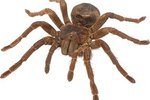The Chaco golden knee tarantula (Grammostola pulchripes), bristling with hair and boasting leg spans of up to 8 inches, may appear formidable, but they are among the calmest spiders in the pet trade. Their needs are simple, and they live for a long time -- 15 years or more. Bear that in mind before rushing to add one to your menagerie.
Natural Habitat
Native to the grasslands of Argentina and Paraguay, the Chaco golden knee tarantula is a ground-living species that burrows when he can. The Chaco golden knee's natural habitat remains warm throughout the year, with dry spells alternating with periods of heavy rainfall.
Tank Setup
Tarantulas don’t need enormous tanks, but Chaco golden knees are large specimens, so you’ll need a habitat with capacity of at least 15 gallons. They’ll feel more secure with a shelter, such as a large piece of bark or a plastic hut. Provide a thick layer, at least 6 inches, of a safe substrate such as coconut fiber or chemical-free potting compost, and a shallow water dish. Keep the tank in a warm room and out of direct sunlight; if the room's not warm year-round, you may have to invest in supplemental heat -- but this creature doesn't need a particularly warm habitat that would necessitate a heat source, generally.
Diet
Like other tarantulas, the Chaco golden knee subsists on a diet of smaller invertebrates, mostly arthropods, in the wild. Feed your captive tarantula crickets, roaches, grasshoppers and similar nontoxic insects. She probably won’t eat that often, about once or twice a week. Remove any insect parts afterward. If she hasn’t eaten a prey item after a few hours, she’s not hungry. Remove it from the tank and feed her again after a day or so -- unless she starts to molt, in which case don’t feed her anything until the process is over.
Maintenance
Keep the substrate fairly dry -- it doesn’t need to be dry as dessicated dust, but don’t let it become soggy, except perhaps under the water bowl. Tarantulas produce very little waste and do not appreciate their habitat being disturbed, so limit cleaning out the tank to once or twice a year.
Precautions
Although generally sweet-natured, the Chaco golden knee, like many other tarantulas, may flick irritating hairs at people when alarmed. Avoid scaring your pet with sudden movements or by picking her up with your bare hands, especially early on. The hairs and venom of this species should cause only minor irritation in most people, but if you are prone to allergies, talk to your doctor before acquiring any tarantula as a pet. Never handle or feed your golden knee while she is molting -- your hands or a prey insect could do immense damage at this vulnerable time.
References
Writer Bio
Judith Willson has been writing since 2009, specializing in environmental and scientific topics. She has written content for school websites and worked for a Glasgow newspaper. Willson has a Master of Arts in English from the University of Aberdeen, Scotland.




